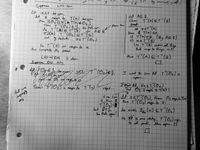Continuous map
- Note: there are a few different conditions for continuity, there's also continuity at a point. This diagram is supposed to show how they relate to each other.
|
|
Note that:
|
| Overview | Key |
|---|
Contents
[<hidetoc>]Definition
Given two topological spaces (X,J) and (Y,K) we say that a map, f:X→Y is continuous if[1]:
- ∀O∈K[f−1(O)∈J]
That is to say:
- The pre-image of every set open in Y under f is open in X
Continuous at a point
Again, given two topological spaces (X,J) and (Y,K), and a point x0∈X, we say the map f:X→Y is continuous at x0 if[1]:
- ∀N⊆Y neighbourhood to T(x0)[f−1(N) is a neighbourhood of x0]
UNPROVED: I suspect that this is the same as ∀O∈K[f(x0)∈O⟹f−1(O)∈J∧x0∈f−1(O)] - this is basically the same just on open sets instead
Claim 1
Claim: The mapping f is continuous ⟺ it is continuous at every point
Sequentially continuous at a point
Given two topological spaces (X,J) and (Y,K), and a point x0∈X, a function f:X→Y is said to be continuous at x0 if[1]:
- ∀(xn)∞n=1[limn→∞(xn)=x⟹limn→∞(f(xn))=f(x)] (Recall that (xn)∞n=1 denotes a sequence, see Limit (sequence) for information on limits)
Claim 2
Claim: f is continuous at x0 using the neighbourhood definition ⟺ it is continuous at x0 using the sequential definition
References
- ↑ <cite_references_link_many_accessibility_label> 1.0 1.1 1.2 Krzysztof Maurin - Analysis - Part 1: Elements
Old page
First form
The first form:
f:A→B is continuous at a if:
∀ϵ>0∃δ>0:|x−a|<δ⟹|f(x)−f(a)|<ϵ (note the implicit ∀x∈A)
Second form
Armed with the knowledge of what a metric space is (the notion of distance), you can extend this to the more general:
f:(A,d)→(B,d′) is continuous at a if:
∀ϵ>0∃δ>0:d(x,a)<δ⟹d′(f(x),f(a))<ϵ
∀ϵ>0∃δ>0:x∈Bδ(a)⟹f(x)∈Bϵ(f(a))
In both cases the implicit ∀x is present. Basic type inference (the Bϵ(f(a)) is a ball about f(a)∈B thus it is a ball in B using the metric d′)
Third form
The most general form, continuity between topologies
f:(A,J)→(B,K) is continuous if
∀U∈K f−1(U)∈J - that is the pre-image of all open sets in (A,J) is open.
